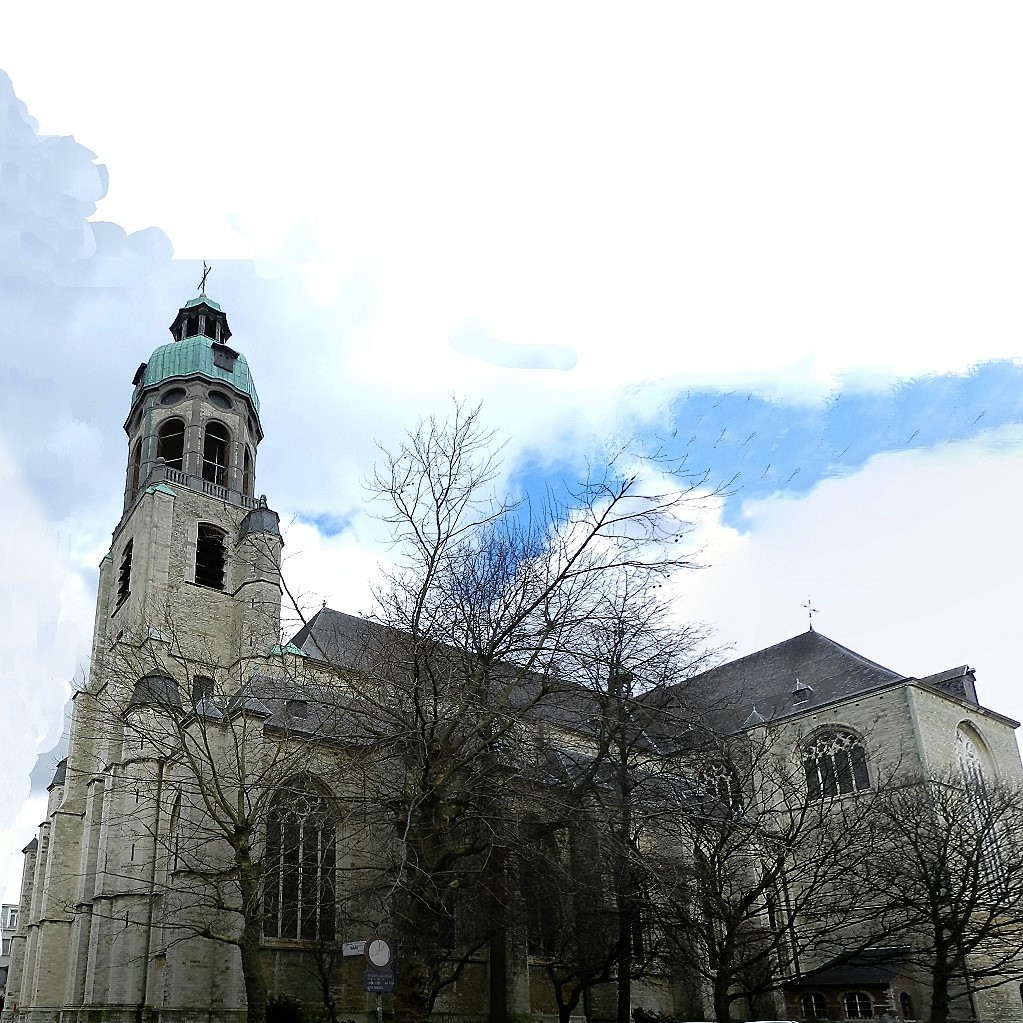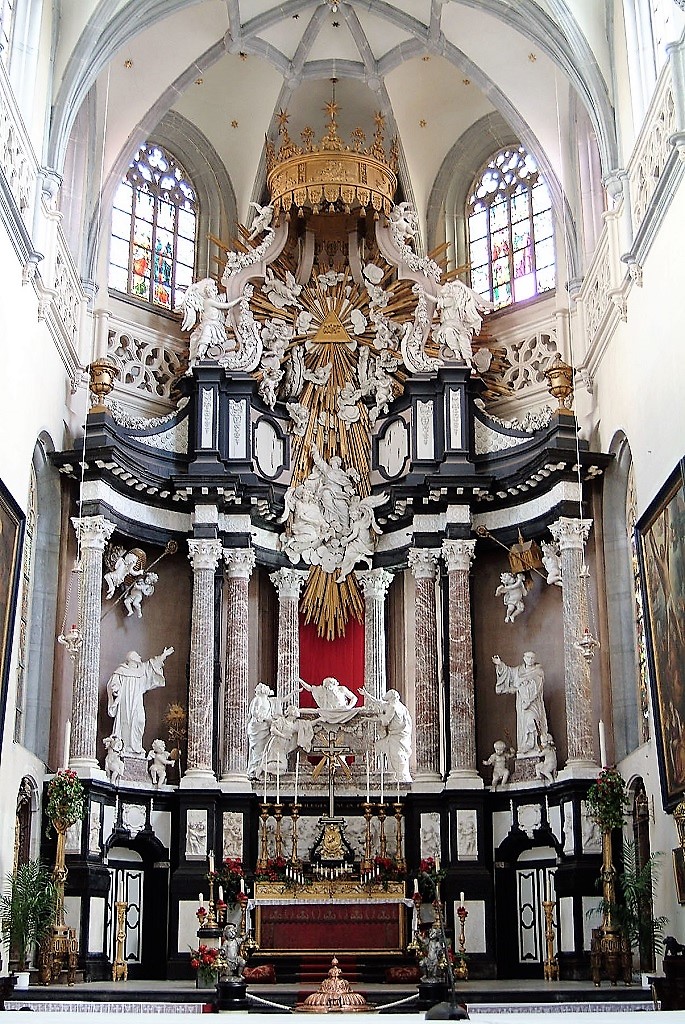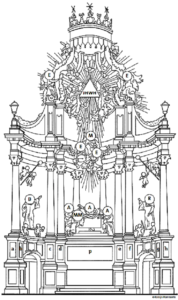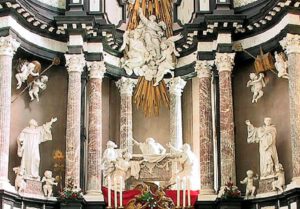Antwerp's St Andrew's Church, a revelation.
The current high altar: not a mere table
The Baroque main altarThe altar is the central piece of furniture used in the Eucharist. Originally, an altar used to be a sacrificial table. This fits in with the theological view that Jesus sacrificed himself, through his death on the cross, to redeem mankind, as symbolically depicted in the painting “The Adoration of the Lamb” by the Van Eyck brothers. In modern times the altar is often described as “the table of the Lord”. Here the altar refers to the table at which Jesus and his disciples were seated at the institution of the Eucharist during the Last Supper. Just as Jesus and his disciples did then, the priest and the faithful gather around this table with bread and wine. is the church’s absolute eye-catcher. Spanning the entire width of the chancel, the altar functions as a giant display for the theatrical ‘live performance’ of a white marble sculptural group. And yet, this monumental piece by Peeter Verbruggen the Elder (1665) and Willem Ignatius Kerricx (around 1729) was not designed for this church, but for the St. Bernard’s AbbeyA set of buildings used by monks or nuns. Only Cistercians, Benedictines, Norbertines and Trappists have abbeys. An abbey strives to be self-sufficient. in Hemiksem. Following the abbey’s dissolution at the time of French Revolutionary Rule, the altar was bought in 1805 and shipped via the river Scheldt. Due to financial difficulties, however, the altar’s actual re-erection was postponed until 1807-1809. Contributions were needed; at a wedding party, parish priestA priest in charge of a parish. Franciscus De Meulder even succeeded in rallying senior French officials to the cause.
As it happened, the giant colossus fitted the space of the new location to perfection – almost. Hindered by the apse’s ribs, the big angels, which originally held the crown, descended to lower places in the construction and were replaced by smaller, suspended angels. Because the choirIn a church with a cruciform floor plan, the part of the church that lies on the side of the nave opposite to the transept. The main altar is in the choir. is narrower here the side porticoes had to be moved slightly diagonally forward, and, in the absence of a choir at the back, the statues were placed against a partition. The bottom part of the altar was completed in marble, but the flaky paint reveals that the cornice’s top part was made of (marbled) wood: a matter of bearing strength, financial and otherwise.
The sculptural group of the Assumption of Mary
and both founders of the Order
In characteristic fashion for the last phase of Baroque altar construction in the Southern Netherlands, seemingly living people participate as ‘extras’ in the action – as seen here, in the work of Willem Ignatius Kerricx (around 1729). Mary’s Assumption is in the spotlight – Mary, the essential model for every human being who, en route in this earthly life, looks forward to the final homecoming in the heavenly House of the FatherPriest who is a member of a religious order..
While several apostles (A) and Mary Magdalene (MM) express their amazement about Mary’s transition into afterlife, angels (E) are carrying Mary (M) upwards, in the movement of her assumption. Their goal can be found above the altar. As Christians believe, God makes himself known to human beings in three ‘forms’: as Creator of all life (God the Father), as a tangible human being (Jesus of Nazareth, God the Son) and as the power of inspiration (God the Holy SpiritThe active power of God in people. It inspires people to make God present in the world. Jesus was ‘filled with the Holy Spirit’ and thus showed in his speech and actions what God is like. People who allow the Holy Spirit to work in them also speak and act like God and Jesus at those moments. See also ‘Pentecost’.). Thus, we find the ‘Holy Trinity’ symbolized by a triangle, in which appears the Hebrew four-letter word (or tetragram) for God: “YHWH”. An immense gilded halo radiates outwards, its long shoots pointing down and carrying Mary along in divine glory.
Above the canopy’s crown, stars allude to Mary as the Woman from the Book of Revelation (12:1): “… clothed with the sun, … and on her head a crown of twelve stars.” With some effort, the visitor may discern three signs of the zodiac set in relief on the gilded frame of the canopy. They are set chronologically: to the left, Leo; in the centre, Virgo; to the right, Libra. This is not coincidental: 15 August corresponds with the period of the constellation of Virgo!
In the side porticoes, two large figures remind us of the altar’s origins. To the left is St. Bernard (B) (1090-1153; commemoration day: 20 August), co-founder of the order of the Cistercians-Bernardines, which was named after him. St. Bernard was the first abbotThe man who has been chosen by the abbey community of which he is a member to lead that community for a fixed period. of Clairvaux, hence the abbot’s staff; the beehive, on the other hand, alludes to the saint’s nickname, ‘Doctor Mellifluus’ (the one whose teaching is as sweet as honey), which Bernard gained from his popular sermons. In pointing at Mary (M) – as does his counterpart – the saintThis is a title that the Church bestows on a deceased person who has lived a particularly righteous and faithful life. In the Roman Catholic and Orthodox Church, saints may be venerated (not worshipped). Several saints are also martyrs. expresses more than a gesture in line with the composition. Bernard was particularly fond of Mary, and several prayers bear witness to this.
To the right is the holy Robert of Molesme (R) (1027-1110; commemoration day: 29 April). Founder of the Cistercian order and co-founder of Cîteaux Abbey, Robert carries a scale model of a church and an abbot’s staff as his attributes. The ring in his hand (partly broken off, by accident) refers to the Marian legend alleging that his mother was given a ring for him by Mary, before his birth. The ring served as a sign of an intense spiritual relationship, and Robert(‘s statue) would present it to his fellow brothers in Hemiksem by way of inspiration, as a way to soften the yoke (carried by the small angel to the right) of monasteryComplex of buildings in which members of a religious order live together. They follow the rule of their founder. The oldest monastic orders are the Carthusians, Dominicans, Franciscans, and Augustinians [and their female counterparts]. Note: Benedictines, Premonstratensians, and Cistercians [and their female counterparts] live in abbeys; Jesuits in houses. life. Indeed, Jesus too said: “Take my yoke upon you, and learn from me; for I am gentle and lowly in heart, and you will find rest for your souls. For my yoke is easy, and my burden is light.” (Matt 11:29,30)
The predella with The Last Supper
The bottom part of the predellaThe base of an altarpiece. Like the altarpiece, the predella may be painted or sculpted. dates back all the way to 1665 and was created by Peeter Verbruggen the Elder. Clothed in an aureole, Jesus sits in the centre and puts his left hand on John’s shoulder to His left; to His right, Peter is given the place of honour. The disciples’ surprise is visible (Matt 26:22, Mk 14:19, Lk 22:23); Jesus has just told them that one among them will betray Him. Holding a filled purse, Judas already sits apart from the company, to the left at the end of the table, and recoils from Jesus’s revealing words.
The table has been set with plates of bread, knives and large salt cellars, as per 17th-century custom. To allow for more visibility, the table top has been purposefully turned and stands quite slanted (and yet, nothing slides off the table…). The EasterThe feast that celebrates the resurrection of Jesus on the 3 day after his death on the cross. This means that Jesus lives on despite his death. This feast is celebrated on the 1 Sunday after the 1 full moon of spring. Lamb on the dish, served according to the customs of Jewish Easter celebration, alludes to Jesus as the new Paschal Lamb. To the left and right, a dish of bread and a Baroque cup (of wine) refer to the EucharisticThis is the ritual that is the kernel of Mass, recalling what Jesus did the day before he died on the cross. On the evening of that day, Jesus celebrated the Jewish Passover with his disciples. After the meal, he took bread, broke it and gave it to his disciples, saying, “Take and eat. This is my body.” Then he took the cup of wine, gave it to his disciples and said, “Drink from this. This is my blood.” Then Jesus said, “Do this in remembrance of me.” During the Eucharist, the priest repeats these words while breaking bread [in the form of a host] and holding up the chalice with wine. Through the connection between the broken bread and the “broken” Jesus on the cross, Jesus becomes tangibly present. At the same time, this event reminds us of the mission of every Christian: to be “broken bread” from which others can live. gifts. In front, beautiful wine and water pitchers are in a saucer. In the right corner, a servant crouches, and under the tablecloth, a large dog is chewing on a bone.
The Last Supper functions as a key event in the evolution from Judaism to Christianity. That evening, Jesus and his disciples celebrated Jewish Easter, remembering the exodus from Egypt. In allusion, a disciple points at the two stone tablets of the Ten Commandments in the background, far left. For Christians, this sign of the legal covenant between God and the chosen Jewish people merely constitutes the ‘Old Covenant’. Curiously, though, these tablets do not depict the ten numbers of the commandments, but rather depict Moses, to whom the law was given.
In the background, far right, a counterpart for the stone tablets can be found: an open book between two chandeliers referring to the Eucharistic celebration, which was instituted by Jesus during the Last Supper: for Christians, and Catholics in particular, this signifies the ‘covenant of love’, alias the New Covenant, between God and all humanity.


In the white marble reliefs, which stand out against the black marble framing of the pillar-bases, an enthusiastic crowd of delightful cherubs and putti is offering liturgical vessels. Note that many of the angels have butterfly wings, no birds’ feathers. From left to right, these are the scenes and objects depicted: (a) The harvest of grapes and wheat: with a [cut off] bundle of stalks of wheat. (b) The vials for water and wine, and a carillon with three bells (visible) for consecrationIn the Roman Catholic Church, the moment when, during the Eucharist, the bread and wine are transformed into the body and blood of Jesus, the so-called transubstantiation, by the pronouncement of the sacramental words.. (c) The so-called ‘washing basin’ (lavabo) for the ritual washing of hands; in the detailed, driven rim of the saucer, we note four small cherub heads. An angel is pouring water into the basin. The ritual takes its name from the corresponding Latin prayer: “Lavabo inter innocentes manus meas.” (“I wash my hands in innocence.”) (d) An angel presses grapes into a gorgeous Baroque chaliceGilded metal cup, usually on a base, which the priest uses for the wine during the Eucharist.. (P) Predella.
(e) Stalks of wheat in bundles, an ingredient of the wafer. (f) Blowing the charcoal, an angel holds up the censerA liturgical object consisting of a bowl suspended from three chains. On the bowl is a lid that is also hanging on a chain. In the bowl, grains of incense are placed on glowing coals, so that they begin to smell. By swinging the censer, the fire is stirred up and the incense fragrance can spread further. The censer is used to honour certain people (the priest, the bishop, the faithful, etc.) or certain objects (a cross, the Bible, the Blessed Sacrament, etc.). by its long chains. This panel serves as counterpart to (b). In other words, the opposites of water and fire serve as each other’s complement… (g) A missalBook containing the liturgical prayers for the day, which are read by the priest during mass. with a ribbon bookmark, two locks and a [most rudimentary] engraving serving as the text’s first impetus. In addition: a book cushion on which the IHS monogram has been embroidered. (h) The supply of harvested grapes and ears of grain, in a large basket on the angel’s head.
Behind both saints’ statues, transparent stained glass windows are blocked from view by the walls. These windows ensure that light enters the church’s inner space in a wondrously beautiful way. As such, the central sculptural group is lit from the southern window from morning till noon; in the afternoon, the ensemble is lit from the side aisleLengthwise the nave [in exceptional cases also the transept] of the church is divided into aisles. An aisle is the space between two series of pillars or between a series of pillars and the outer wall. Each aisle is divided into bays.. A beam of light can then be seen gliding gradually upwards, moving from Bernard’s side at the left, across Mary and further to the right; by nightfall, the beam touches the heavenly aureole. Every sunny summer day, this miracle is performed…




